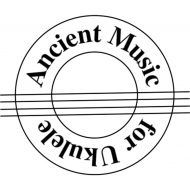Selection of Music for this Book
All the pieces in this book were written for the vihuela and voice and are from Libro V of Fuenllana’s publication Libro de música para vihuela intitulado Orphenica Lyra (Seville, 1554).
The vocal line is arranged as the first part in the music (i.e. stems up on the notes) and is based on the tab markings in the original folio being written in red while the vihuela part is written in black. The vocal melody sometimes drops below the pitch of the notes in the accompaniment. For the villancicos of Flecha and Guerrero, the bass vocal line has been raised an octave to fit the musical range of the ukulele, which causes conflicts with the accompaniment (i.e. two notes to be played on the same string), so the two parts have been written out separately. For two of the villanescas, the vocal part has also been written out separately as it is below the range of the ukulele (it can be played on guitar with drop-D tuning).
Notes on the Composers and Pieces
All sources are Wikipedia.
Derived from medieval dance forms, the 15th century a villancico was a type of popular song sung in the vernacular and frequently associated with rustic themes. It is a poetic and musical form and was sung with or without accompanying instruments. Originally a folk song, frequently with a devotional song or love poem as text, it developed into an art music genre. With the decline in popularity of the villancicos in the 20th century, the term became reduced to mean merely “Christmas carol”.
Villanesca (also villanella) s a form of light Italian secular vocal music which originated in Italy just before the middle of the 16th century. The subject matter is generally rustic, comic, and often satirical; frequently the mannerisms of art music, such as the madrigal, are a subject of parody.
Miguel de Fuenllana (ca 1500 – 1579) was a Spanish vihuelist and composer of the Renaissance. Little is known of his life. It is assumed from his name that his roots lie in the municipality of Fuenllana, in the province of Ciudad Real, although he was born in Navalcarnero, Madrid. He was blind from birth and servied in the Spanish court to Philip II of Spain and Isabel de Valois, third wife of Philip II. He later served Don Sebastian of Portugal in Lisbon starting in 1574.
He published a Libro de música para vihuela intitulado Orphenica Lyra (Seville, 1554), known briefly as Orphenica Lyra. His style is polyphonic and he was adept at finding apt harmonies and counterpoint to popular melodies.
Orphenica Lyra constitutes the largest collection of music for vihuela (and renaissance guitar). It is made up of 188 pieces spread over six books. Of these, approximately two-thirds are arrangements of pieces or transcriptions of polyphonic vocal work by other Spanish, Flemish and Italian Renaissance composers.
Juan Vásquez (ca 1500 – 1560) was a Spanish priest and composer of the Renaissance. He can be considered part of the School of Andalusia group of composers along with Francisco Guerrero, Cristóbal de Morales, Juan Navarro Hispalensis and others.
Giovanni Domenico de Nola (ca 1510/20 – 1592) was an Italian composer and poet of the Renaissance.
Vincenzo Fontana (fl 1550) was an Italian composer. He was mainly known for his canzoni villanesche.
Mateo Flecha the Elder (1481–1553) was a Catalan composer born in Kingdom of Aragon, in the region of Prades. He is sometimes known as “El Viejo” (the elder) to distinguish him from his nephew.
Francisco Guerrero (1528 – 1599) was a Spanish Catholic priest and composer of the Renaissance. He was born and died in Seville.
Notes on the Tabulature
Italian tabulature was used by Spanish composers Mudarra, Fuenllana and others in the 16th century in music for the vihuela and Renaissance guitar. It almost looks like modern tabulation in that it uses numbers to represent the frets (zero for an open string, “1” for the first fret, “2” for the second fret, etc.) The duration of the notes are above the staff and look like our modern notes (whole notes, half notes, quarter notes), including dotted notes. Italian tabulature has the highest sounding string on the bottom line and the lowest sounding string on the top line (i.e. upside down from modern tabulation).
